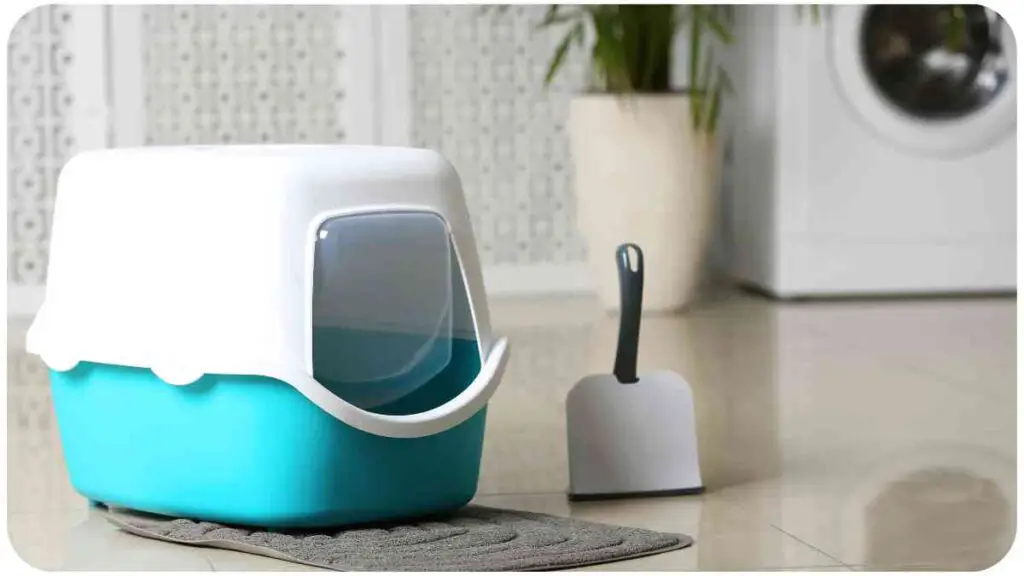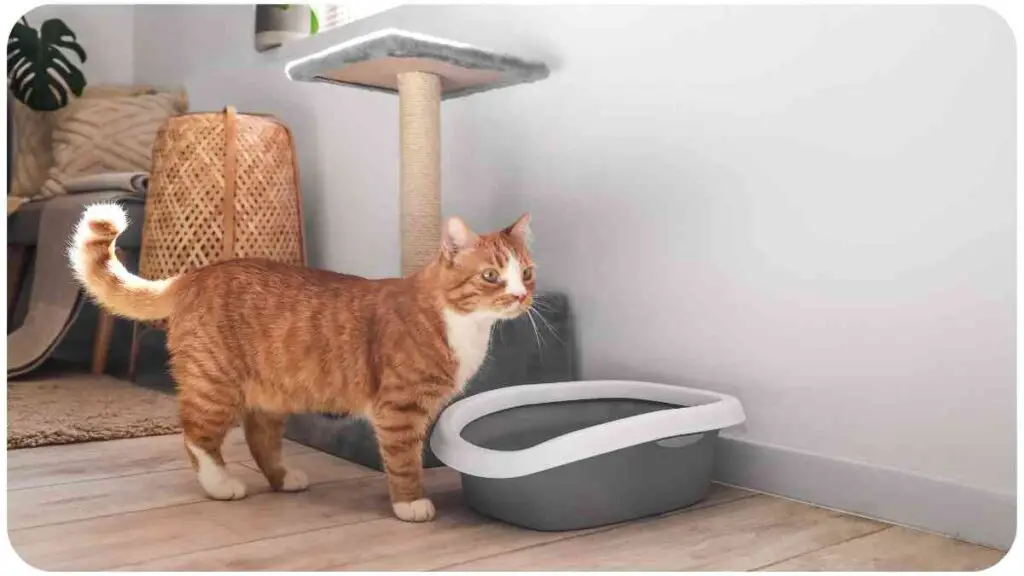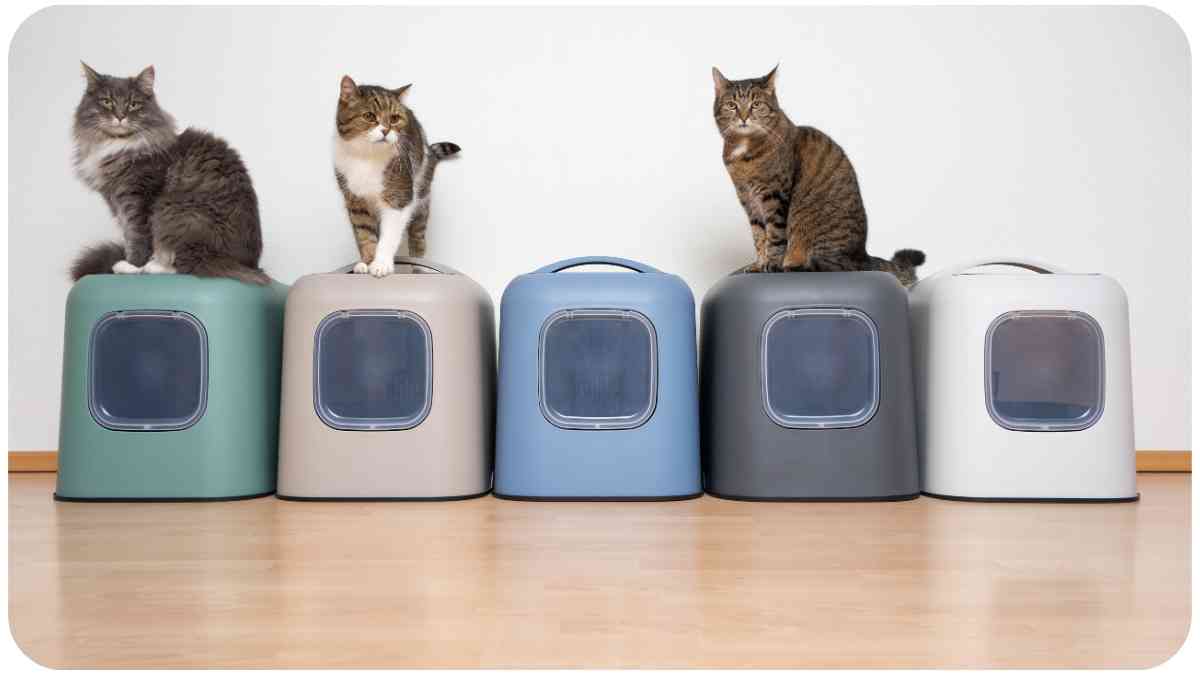As a dedicated cat lover, I understand the paramount importance of ensuring our feline companions’ well-being. The market for pet products has seen remarkable innovations, and automatic litter boxes, exemplified by the popular ScoopFree brand, have become a hot topic.
But the question remains: do these modern marvels alleviate or exacerbate our cats’ stress levels? In this article, we embark on a journey to uncover the truth behind the myth and provide you with a comprehensive guide to understanding and choosing automatic litter boxes for your furry friend.
| Takeaways |
| Gradual introduction helps cats adapt to automatic litter boxes. |
| Positive reinforcement and treats create positive associations. |
| Consider your cat’s personality and preferences when choosing. |
| Quieter models and user-friendly interfaces reduce stress. |
| Observation of behavior aids in gauging your cat’s comfort. |
| Cats can adjust to new technology with patience and familiarity. |
| The human-cat bond can be strengthened through trust and care. |
| Address common myths to make informed decisions. |
| Finding balance between convenience and comfort is crucial. |
| Empathy and respect guide choices for your cat’s well-being. |
Understanding Automatic Litter Boxes

Before we delve into the impact on our cats, let’s establish a clear understanding of what automatic litter boxes entail. These automated systems are designed to simplify the often-dreaded task of scooping litter. With self-cleaning mechanisms and innovative technology, they aim to enhance convenience for cat owners while maintaining a clean and odor-free environment. But do they achieve this goal without causing stress to our feline companions? Let’s find out.
Cat owners can ease the transition to the litter box with proper training techniques. Explore effective tips for encouraging your feline friend to use the litter box consistently and comfortably.
The Science of Feline Stress
Cats are creatures of habit, and any change in their environment can potentially trigger stress. This is particularly true for sudden alterations in their territory or daily routines. As a seasoned veterinarian, Dr. Emily explains, “Feline stress is a genuine concern, and it’s crucial to evaluate any new element we introduce into their lives.”
To properly assess the impact of automatic litter boxes on cats, we need to consider the factors that contribute to feline stress. These include unfamiliarity, noise sensitivity, and changes in their bathroom habits. Our next section will address each of these aspects in detail.
Debunking the Myth: Do Automatic Litter Boxes Stress Cats?
Let’s address the elephant in the room: are automatic litter boxes truly stressors for our cats? Based on my extensive experience and insights from veterinarians like Dr. Michael, it’s time to debunk this myth and explore the real factors at play.
Understanding the fundamental do’s and don’ts of cat training is crucial for a harmonious relationship. Learn more about cat training principles to create a positive and enriching environment for both you and your cat.
4.1 Unfamiliarity and Adjustment Period
| Table 4.1: Adjusting to the New |
| Concern |
| Unfamiliar Apparatus |
| The Scent of Change |
Understanding that cats need time to adjust to new elements in their surroundings is key to providing a stress-free transition. Gradual introduction, along with maintaining a reassuring atmosphere, can significantly ease their adjustment period.
Enhance your cat’s cognitive and physical abilities with the Catit Senses Play Circuit. Discover valuable tips and tricks for optimizing your cat’s experience with this interactive and stimulating toy.
4.2 Noise and Vibration Concerns
| Table 4.2: Noise and Vibration |
| Concern |
| Startling Sounds |
| Vibration Apprehension |
It’s understandable that the sudden noises and vibrations of automatic litter boxes can raise concerns. However, advancements in technology allow for quieter operations that are less likely to trigger stress responses.
4.3 Maintenance and Odor Issues
| Table 4.3: Maintenance and Odor |
| Concern |
| Neglect Due to Automation |
| Lingering Odors |
Automated systems do require diligent maintenance to ensure a pleasant experience for your cat. Regular upkeep not only addresses potential stress but also promotes a clean and odor-free environment.
In the next section, we’ll discuss how to select the right automatic litter box to align with your cat’s preferences and needs.
Choosing the Right Automatic Litter Box
Selecting the perfect automatic litter box for your furry companion involves understanding their unique personality and preferences. Let’s delve into the factors to consider to ensure a harmonious match between technology and your cat’s well-being.
Investing time in cat training yields numerous benefits for both cats and their owners. Explore the compelling reasons and advantages of cat training to foster a strong bond and a well-behaved feline companion.
5.1 Consideration of Cat’s Personality
When choosing an automatic litter box, it’s imperative to consider your cat’s temperament. Is your feline friend confident and adaptable, or does change tend to make them nervous? Cats with a more easygoing nature might adjust quickly to new contraptions, while those who are more cautious might require additional time and patience during the transition.
5.2 Noise Levels and Technology
| Table 5.2: Noise Levels and Technology |
| Factor |
| Noise Sensitivity |
| User-Friendly Interface |
Minimizing noise and simplifying technology are crucial steps in ensuring your cat’s acceptance of the new litter box. A user-friendly design can make the transition smoother for both you and your feline friend.
The Furbo Dog Camera offers a seamless way to connect with your canine companion. Learn about setting up and the benefits of this innovative device, providing insights into your dog’s behavior and enhancing your relationship from afar.
5.3 Litter Preferences and Box Size
| Table 5.3: Litter Preferences and Box Size |
| Consideration |
| Litter Texture and Type |
| Box Dimensions |
Adhering to your cat’s litter preferences and ensuring the box is spacious enough will contribute to a positive experience. Remember, it’s about creating an environment that aligns with their comfort.
The Role of Training and Familiarization
Incorporating training and gradual familiarization is pivotal in introducing any new element to your cat’s routine. Whether it’s a new litter box or a different feeding schedule, cats thrive on consistency and predictability. Allow them to explore the new contraption at their own pace, rewarding each successful interaction with treats and praise.
Monitoring Your Cat’s Response
Understanding your cat’s body language and behavioral cues is essential in assessing their response to the automatic litter box. Let’s take a closer look at these indicators.
7.1 Behavioral Indicators of Stress
| Table 7.1: Behavioral Indicators of Stress |
| Indicator |
| Excessive Hiding |
| Increased Aggression |
| Changes in Grooming Habits |
Observing changes in your cat’s behavior can provide insights into their emotional well-being. Should you notice any of these indicators, it might be time to reassess the situation.
7.2 Signs of Acceptance and Comfort
| Table 7.2: Signs of Acceptance and Comfort |
| Sign |
| Curious Exploration |
| Relaxed Posture |
| Normal Bathroom Behavior |
Positive responses to the new litter box demonstrate that your cat is adapting well to the change. Remember that patience is key during this adjustment phase.
Expert Insights: What Veterinarians Say
8.1 Dr. Emily’s Perspective
| Table 8.1: Dr. Emily’s Perspective |
| Insight |
| Gradual Introduction |
| Positive Reinforcement |
As a seasoned veterinarian, Dr. Emily recommends a patient and positive approach to ensure your cat’s comfort during this transition.
8.2 Dr. Michael’s Take on the Matter
| Table 8.2: Dr. Michael’s Take |
| Insight |
| Individual Variability |
| Communication and Observation |
Dr. Michael’s perspective emphasizes the uniqueness of each cat’s response, underscoring the importance of attentive observation.
Real User Experiences: A Deep Dive
The best way to gain insights into the impact of automatic litter boxes is by hearing from cat owners who have gone through the process. Let’s explore two real user experiences that shed light on the journey of transitioning to an automated litter box.
9.1 Bella’s Transition to Automatic Litter Box
Bella, a charming calico cat, initially displayed apprehension toward her new automatic litter box. Her owner, Sarah, took a patient approach, gradually introducing Bella to the contraption.
Through positive reinforcement, including treats and affection, Bella’s curiosity overcame her initial uncertainty. As Sarah recalls, “It took a bit of time, but watching Bella confidently use the new litter box made the transition worth every effort.”
9.2 Simba’s Daily Routine with ScoopFree
Simba’s owner, Mark, opted for the ScoopFree automatic litter box due to its sleek design and minimal noise. Simba, a playful tabby, quickly adapted to the automated system. Mark shares, “Simba’s acceptance was almost immediate. The box’s quiet operation and consistent cleanliness seemed to alleviate any concerns he might have had.”
Tips for Introducing an Automatic Litter Box

Transitioning to an automatic litter box requires patience and strategic steps. Here are some tips to ensure a smooth adjustment period:
10.1 Gradual Transition and Observation
| Table 10.1: Gradual Transition and Observation |
| Tip |
| Slow Introduction |
| Observation |
10.2 Creating a Positive Association
| Table 10.2: Creating a Positive Association |
| Tip |
| Rewards and Treats |
| Familiar Items |
10.3 Being Mindful of Maintenance
| Table 10.3: Being Mindful of Maintenance |
| Tip |
| Regular Cleaning |
| Litter Replacement |
The Human-Cat Bond: Strengthening Through Trust
The relationship between a cat and their owner is built on trust and mutual understanding. Transitioning to an automatic litter box can be an opportunity to strengthen this bond. Just as we trust our cats to express their needs, they trust us to create a comfortable and nurturing environment.
Addressing Common Misconceptions
Misconceptions around automatic litter boxes can cloud our judgment. Let’s clarify some of the most common myths.
12.1 Separating Facts from Fiction
| Table 12.1: Separating Facts from Fiction |
| Myth |
| Automatic Boxes Always Stress Cats |
| Cats Reject All New Technology |
| Noise Always Equals Stress |
12.2 Myth Busting with Data and Experience
| Table 12.2: Myth Busting with Data and Experience |
| Myth |
| Cats Cannot Adjust to Change |
| Automated Boxes Sacrifice Hygiene |
| Cats Will Avoid the Box at All Costs |
Finding Balance: Convenience and Feline Comfort
As responsible cat owners, our priority is to find the balance between convenience and our cats’ well-being. Automatic litter boxes offer the potential to streamline maintenance while ensuring our feline friends are comfortable in their environment.
By considering our cats’ preferences, personalities, and gradual adjustment, we can achieve this harmony.
A Cat’s Perspective: What Matters Most
Understanding our cats’ perspective allows us to make informed decisions. While the transition to an automatic litter box might seem significant to us, it’s ultimately about enhancing their comfort and reducing stress. Our role as caregivers involves respecting their needs and providing an environment that nurtures their physical and emotional health.
Final Verdict: Should You Invest in an Automatic Litter Box?
After a thorough exploration of the world of automatic litter boxes and their impact on cats, the verdict is in: yes, investing in an automatic litter box can be a positive choice for both you and your feline companion.
With careful consideration, gradual introduction, and adherence to your cat’s unique needs, these modern conveniences can streamline your cleaning routine while minimizing stress for your furry friend.
Remember, the key lies in understanding your cat’s personality, preferences, and comfort zones. Patience and positive reinforcement are your allies during the transition. Technology, when introduced thoughtfully, can complement your efforts to create an environment that resonates with your cat’s well-being.
In the end, the journey of selecting an automatic litter box is a testament to your commitment as a cat owner. As you embark on this adventure, let empathy and respect guide your decisions. By prioritizing both convenience and feline comfort, you’re sure to discover a solution that harmonizes seamlessly with your cat’s lifestyle.
In the tapestry of our companionship with cats, the threads of trust, understanding, and care are woven. As we seek ways to enhance their lives, let us remember that every choice we make is a gesture of love.
Thank you for joining me on this exploration of automatic litter boxes and their impact on our feline friends. May your journey with your beloved cat be filled with joy, companionship, and moments of connection.
Further Reading
For more insights into the world of automatic litter boxes and their impact on cats, you might find these resources helpful:
- Quora: User Experiences with Automatic Litter Boxes Discover firsthand accounts from cat owners who have tried various automatic litter boxes, including their cats’ reactions and adaptation to these innovative systems.
- Amazon: PetSafe ScoopFree Automatic Litter Box Reviews Explore user reviews and feedback on the PetSafe ScoopFree, one of the popular automatic litter boxes available. Learn from the experiences of other cat lovers who have incorporated this technology into their homes.
- Insider: Best Self-Cleaning Litter Boxes Guide Check out this comprehensive guide from Insider, featuring a selection of the best self-cleaning litter boxes on the market. Gain valuable insights into various brands and models that cater to both convenience and feline comfort.
FAQs
How do I introduce my cat to an automatic litter box?
Introducing your cat to an automatic litter box involves gradual familiarization. Place the new box in a quiet and accessible area, allow your cat to explore at their own pace, and provide positive reinforcement such as treats and affection.
Will the noise of an automatic litter box stress my cat?
Modern automatic litter boxes often come with quieter mechanisms to minimize noise-related stress. Gradual introduction and exposure can help your cat adapt to the new sounds.
Are all cats comfortable with using automatic litter boxes?
Cats have individual personalities, so their responses to automatic litter boxes can vary. Some cats might adjust quickly, while others might need more time to become comfortable with the new contraption.
How often should I clean the automatic litter box?
Regular maintenance is essential. Check the manufacturer’s recommendations for litter replacement and cleaning frequency to ensure a clean and odor-free environment for your cat.
Can automatic litter boxes enhance the human-cat bond?
Yes, they can. When introduced thoughtfully and positively, automatic litter boxes can streamline your cleaning routine, giving you more time to spend quality moments with your cat.

My name is Dr. Hellen James, and I am a veterinarian with over 20 years of experience in pets training. My qualifications are that I have been involved in the pet industry since I was 16 years old. I have worked as a groomer, dog trainer, and veterinarian.


